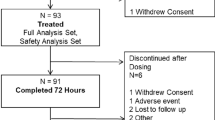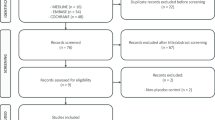Abstract
The objective of the study was to investigate the effect of a long acting local anesthetic infiltration around nephrostomy tract on pain control after percutaneous nephrolithotomy. Forty-six patients with kidney stones of >2 cm undergoing single access subcostal percutaneous nephrolithotomy (PCNL) were enrolled in the study. Patients were randomized to levobupivacaine (Group I) and saline (Group II) infiltration groups. Group I patients (n = 23) had 75 mg/30 cc levobupivacaine infiltration around the access site after placement of nephrostomy catheter. Group II patients had 30 cc saline infiltration. Postoperatively the patients were given narcotics on demand. Pain scores were collected using a visual analog scale (VAS) at 2, 4, 6, 8, 12 and 24 h postoperatively. The VAS scores, time to analgesic demand, ambulation, and duration of nephrostomy tube were compared between two groups. The mean age was 44 and 45 years in group I and II patients. There were no significant differences between the two groups with regard to demographics, surgery or stone characteristics. Comparison of pain scores at all postoperative time points was not statistically significant between the two groups. Time to first analgesic demand and total narcotic analgesic dose per patient were 1.2 ± 1.05 and 4.04 ± 1.57 h; and 96 and 112 mg for group I and II patients (p = 0.009 and p = 0.41, respectively). Ambulation time and duration of nephrostomy tube were also similar. Infiltration of nephrostomy tract site with levobupivacaine does not have a superior effect compared to saline on postoperative pain control in patients undergoing PCNL.To prolong analgesia, the effect of intermittent tract injections or continuous infusion of local anesthetics for the postoperative maintenance of the local anesthetic effect seems worth to investigate in future studies.

Similar content being viewed by others
References
Pietrow PK, Auge BK, Lallas CD, Santa-Cruz RW, Newman GE, Albala DM, Preminger GM (2003) Pain after percutaneous nephrolithotomy: impact of nephrostomy tube size. J Endourol 17:411–414
Ni S, Qiyin C, Tao W, Liu L, Jiang H, Hu H, Han R, Wang C (2011) Tubeless percutaneous nephrolithotomy is associated with less pain and shorter hospitalization compared with standard or small bore drainage: a meta-analysis of randomized, controlled trials. Urology 77:1293–1298
Zhong Q, Zheng C, Mo J, Piao Y, Zhou Y, Jiang Q (2013) Total tubeless versus standard percutaneous nephrolithotomy: a meta-analysis. J Endourol 27:420–426
Haleblian GE, Sur RL, Albala DM, Preminger GM (2007) Subcutaneous bupivacaine infiltration and postoperative pain perception after percutaneous nephrolithotomy. J Urol 178:925–928
Uğraş MY, Toprak HI, Günen H, Yücel A, Gunes A (2007) Instillation of skin, nephrostomy tract, and renal puncture site with ropivacaine decreases pain and improves ventilator function after percutaneous nephrolithotomy. J Endourol 21:499–503
Jonnavithula N, Pisapati MVLN, Durga P, Krishnamurthy V, Chilumu R, Reddy KVB (2009) Efficacy of peritubal local anesthetic infiltration in alleviating postoperative pain in percutaneous nephrolithotomy. J Endourol 23:857–860
Parikh GP, Shah VR, Modi MP, Chauhan NC (2011) The analgesic efficacy of peritubal infiltration of 0.25 % bupivacaine in percutaneous nephrolithotomy-a prospective randomized study. J Anaesthesiol Clin Pharmacol 27:481–484
Gökten OE, Kilicarslan H, Dogan HS, Turker G, Kordan Y (2011) Efficacy of levobupivacaine infiltration to nephrostomy tract in combination with intravenous paracetamol on postoperative analgesia in percutaneous nephrolithotomy patients. J Endourol 25:35–39
Shah HN, Shah RH, Sodha HS, Khandkar AA, Gokhale A (2012) A randomized control trial evaluating efficacy of nephrostomy tract infiltration with bupivacaine after tubeless percutaneous nephrolithotomy. J Endourol 26:478–483
Honey JR, Ghiculete D, Ray AA, Pacet KT (2013) A randomized, double blind, placebo-controlled trial of intercostals nerve block after percutaneous nephrolithotomy. J Endourol 27:415–419
Kıraç M, Tepeler A, Bozkurt OF, Elbir F, Ozluk C, Armagan A, Unsal A, Biri H (2013) The efficacy of bupivacaine infiltration on the nephrostomy tract in tubeless and standard percutaneous nephrolithotomy: a prospective, randomized, multicenter study. Urology 82:526–531
Dalela D, Goel A, Singh P, Shankwar SN (2004) Renal capsular block: a novel method for performing percutaneous nephrolithotomy under local anesthesia. J Endourol 18:544–546
Chen Y, Zhou Z, Sun W, Zhao T, wang H (2011) Minimally invasive percutaneous nephrolithotomy under peritubal local infiltration anesthesia. World J Urol 29:773–777
Aravantinos E, Karatzas A, Gravas S, Tzortzis V, Melekos M (2007) Feasibility of percutaneous nephrolithotomy under assisted local anaesthesia: a prospective study on selected patients with upper urinary tract obstruction. Eur Urol 51:224–228
Allister Mc, Lim K, Torrey R, Chenoweth J, Barker B, Baldwin DD (2011) Intercostal vessels and nerves are at risk for injury during supracostal percutaneous nephrolithotomy. J Urol 185:329–334
Leone S, Di Cianni S, Casati A, Fanelli G (2008) Pharmacology, toxicology, and clinical use of new long acting local anesthetics, ropivacaine and levobupivacaine. Acta Biomed 79:92–105
Conflict of interest
There exist no financial or commercial interests by any of the authors.
Author information
Authors and Affiliations
Corresponding author
Rights and permissions
About this article
Cite this article
Tüzel, E., Kızıltepe, G. & Akdoğan, B. The effect of local anesthetic infiltration around nephrostomy tract on postoperative pain control after percutaneous nephrolithotomy. Urolithiasis 42, 353–358 (2014). https://doi.org/10.1007/s00240-014-0680-1
Received:
Accepted:
Published:
Issue Date:
DOI: https://doi.org/10.1007/s00240-014-0680-1




